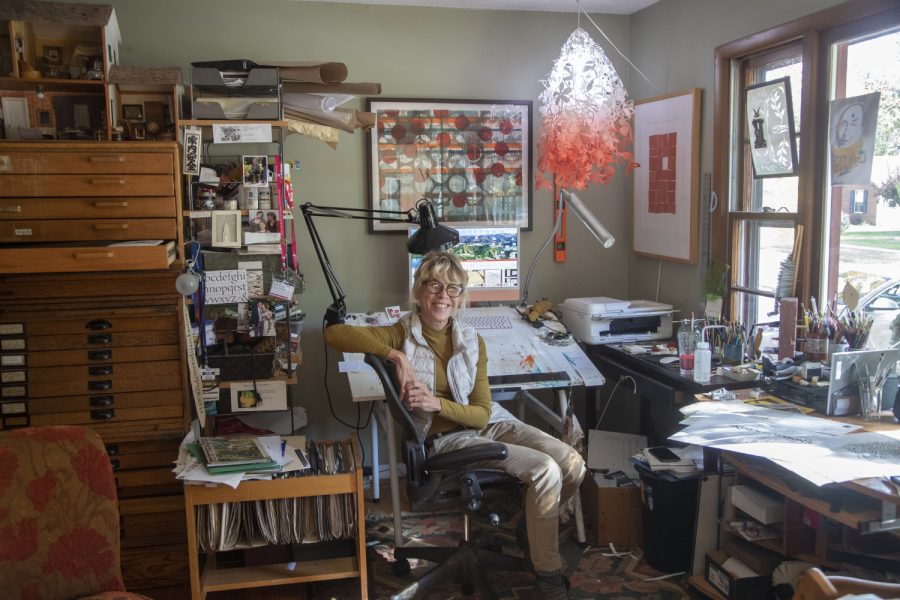UI professor Cheryl Jacobsen teaches students lost art of calligraphy
University of Iowa calligraphy professor Cheryl Jacobsen is also a freelance artist who shares her artifact art and lettering with Iowa City and has for almost 30 years.
Cheryl Jacobsen, surrounded by supplies and her projects, in her workstation at her home studio, on Wednesday, Oct. 12, 2022.
October 18, 2022
Using quick and intricate swishes of ink on paper to create one-of-a-kind lettering, Cheryl Jacobsen has captivated Iowa City with the art of freelance calligraphy. She is a freelance artist and a professor at the University of Iowa’s Center for the Book for almost 30 years.
Over the course of her career, she has participated in numerous teaching jobs, calligraphy conventions, and workshops around the world.
As a young girl, she was given her first calligraphy manuals by her grandfather, and fell in love with the art of producing decorative lettering with ballpoint and fountain pens. Her lifelong passion for calligraphy slowly drove her to return to art after working in the genetics lab, and calligraphy became her career.
“I really love the translation of movement into writing, and whether it’s very legible — or almost more when it’s illegible because you really capture both movement and meaning — creating visual representations of people’s ideas,” Jacobsen said.
Jacobsen started college at Iowa State University on the pre-veterinary track because she loved animals. She eventually switched to medical illustrations to work more closely with drawing and graphic design. After graduating in 1984, she moved to Iowa City and worked as a research assistant in a genetics lab studying fruit flies.
When Jacobsen found calligraphy again, she pursued freelance art instead of attending graduate school. Some of her first assignments involved making calligraphic signs for clients.
She continues to make hundreds of signs today for the Iowa Writers’ Workshop. She also designs wedding invitations and special projects like the adaptation of the original “Beowulf” text on vellum in Old English, which she displayed at the James Theater for the “Beowulf” play on Sept. 30. Thanks to the rich arts scene in Iowa City, Jacobsen said has been exposed to a wide array of jobs and opportunities.
“It’s the people that live here with all their diverse ideas and the whole interchange that I’ve gotten to have with other scholars through the university, especially sort of pulling together manuscript people and crafts people is really, really exciting,” Jacobsen said.
Jacobsen said calligraphy is more difficult than it sounds because people are not used to writing in such an artistic way. It requires a certain amount of perfectionism and a certain amount of release. Jacobsen said she struggles to help her students find this balance when she teaches.
Jacobsen combines mediums of drawing and painting with various objects that she is drawn to. These artifact objects are more antiquated but can be anything Jacobsen finds weird.
She started her assemblages later in her career when she combined objects and writing with photographs. Since then, her work has physically and figuratively grown.
“It’s less about me deciding what’s going to happen and more about the objects telling me what they want and who they want to be around and what they want to be because I’ll put them down and be like, ‘no — yes,’” Jacobsen said. “It’s kind of magic, and it has very little to do with me, which is a really fun way to work.”
One of Jacobsen’s favorite aspects of teaching is seeing her students appreciate their calligraphy skills no matter where life takes them.
“I’ve had at least three students now who have gone on to be professional calligraphers themselves,” Jacobsen said. “Other people that have come back here and gotten their grad degree through the Center for the Book and are going off and studying either things they’ve learned here alongside with calligraphy, or just going out in the world as a book arts person, which is so rewarding.”
Jacobsen worries the convenience of writing quickly and society’s shift from paper to electronics is killing the art of calligraphy. Writing quickly and typing on a computer replace the process of slow and purposeful movement encouraged by calligraphy. Jacobsen hopes her students will embrace this movement so people can continue appreciating calligraphy.
“I love using my hands, and I love materiality, and obviously I love putting things together, but I like the simplicity of how the pen works on the page and how you can create calligraphic lines and expressive marks so you can feel peoples’ life through the writing,” Jacobsen said.



